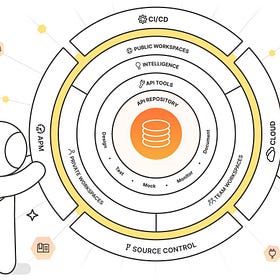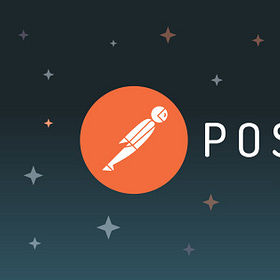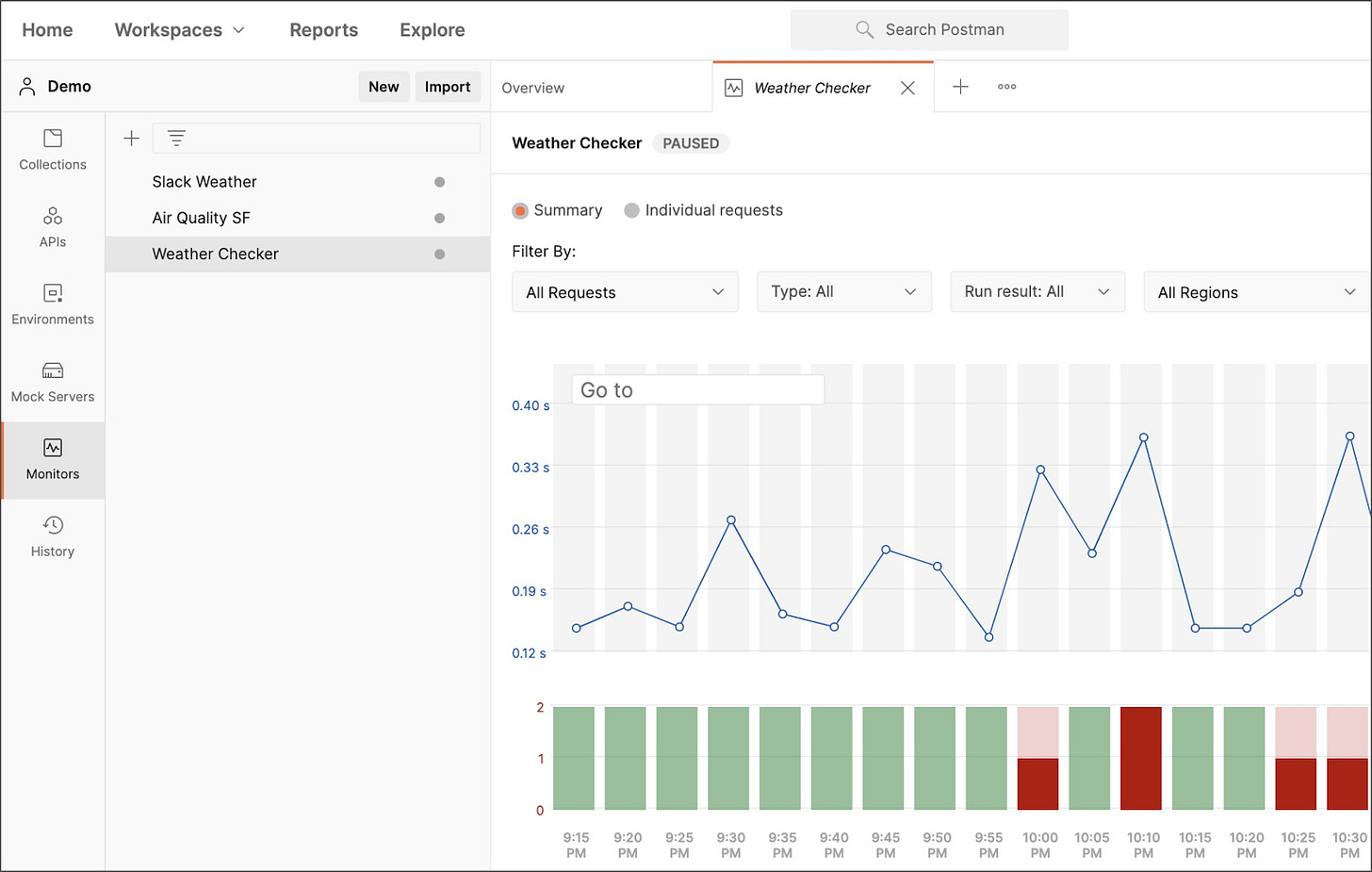A Bird’s Eye View of the Postman Ecosystem (Postman 1 of 4)
Overview of Postman's powerful features and tools
Introduction
Many developers, myself included until recently, still don’t know about Postman’s extensive capabilities and features beyond the standard app, collections, and requests platform. Postman is a comprehensive tool designed to be an entire platform and source of truth for your individual or team’s API development and testing.
Postman has defined an API lifecycle and, with the evolution of more sophisticated web and application software over the last two decades, has over time created a unique and creative set of tools to address different touch points in this API lifecycle.
One of the most important parts of Postman that developers don’t know today is about its open-source, public license Collections Format, which allows you to export, import and share public or private APIs outside of Postman. Yes - in the process you do lose some of Postman’s unique proprietary capabilities, but it’s quite honorable the approach that Google’s Postman team has taken over time to create a platform that provides a truly professional tool for developers to design, develop, test, and continuously release APIs in a standardized way.
This blog post is just a summary of the many features that Postman comes with, including links to Postman developer documents to explore them more in depth. This is also the first blog post of four (from me) about Postman’s ecosystem. In part 2, we will explore the top features that beginner to advanced developers will want to use in their everyday work for developing first-class backend software systems.
Four Part Series
A Bird’s Eye View of the Postman Ecosystem (Postman 1 of 4)
Introduction Many developers, myself included until recently, still don’t know about Postman’s extensive capabilities and features beyond the standard app, collections, and requests platform. Postman is a comprehensive tool designed to be an entire platform and source of truth
Diving-Deep: Postman’s Open-Source Collections Format (Postman 3 of 4)
Introduction The Postman Collection Format is a standardized specification and format to create, use and share API environments. It was developed by Postman, the most popular API development and testing tool, but a Collection Format is an open-source, open specification in JSON format.
Beyond the Basics: Advanced Postman Tips for Superman-Like APIs (Postman 4 of 4)
Postman has become an indispensable tool for developers working with APIs. Most of us start just know the basic requests, but’s there’s a lot of hidden features that can create an exceptional experience for developers. This final post of the series focuses on a selective set of advanced features.
Key Features
Send requests
Write scripts
Use collections
Use Postman Flows
Use Postman CLI
Collaborate in Postman
Design and develop
Document your API
Monitor your API
API Governance and API Security
Administration
User reports
Developer resources
Integrations
1 / Sending requests
Sending API requests in Postman is the primary feature
Postman allows you to create HTTP requests for all method types (GET, POST, PUT, PATCH, DELETE, …) as well as send requests for other protocols like GraphQL
Requests are easy to create, save and reuse
2 / Write scripts
The Postman app comes with a Node runtime environment that is able to execute Javascript code
You can add pre- or post-request scripts and utilize variables to have dynamic requests and behavior
Scripts are commonly use for embedding variables into the header or body or for testing and asserting statements
Use collections
Collections are the group entity that allow us to organize a set of requests together - you can think of them as parent folders
Collections can also be further organized and segmented into groups and sub-groups of requests - on Postman, these look like folders
The secondary benefit of collections, beyond their ability to keep things organized for us, is the capability that Postman comes with to allow us to run an entire group or collection (set of groups), which will trigger every request inside that group/collection
We can trigger these groups or collections manually or automatically (on schedule from a CI/CD pipeline using the Postman CLI tool)
Use Postman Flows
Postman Flows is a visual tool for creating API workflows
You can use Flows to chain requests, handle data and create real-world flows
Flows can act as an intermediary short-term or even potentially long-term no-code alternative to CD/CI testing
Flows can also be used for document generation on production APIs - we can create a flow that given a set of dynamic inputs generates a set of outputs and reports with the data - and with Postman’s extensive integrations, we can take the data outside the platform with Flows and integrations
Use Postman CLI
The Postman CLI is just a CLI tool that allows us to run Postman actions from the command line - an incredibly powerful feature, which allows us to take our clicks and groupings into automated and repeatable CI/CD pipelines
The Postman CLI allows you to execute collections and requests from the CLI
You can also utilize it to get information or apply modifications to existing workspaces, collections, requests
Collaboration inside Postman
Postman has an extensive set of collaboration features - which allow us to define organizations, workspaces, admins, roles, permission groups, and utilize all these collaborative functions to have multiple members work with and contribute to our development and testing inside Postman
Common features
Define organizational roles, permissions and users
Define shared workspaces of collections and configurations
Allow people to comment on specific entities like collections or requests
Allow versioning on API definitions and scripts
Design and develop
Postman follows an API-first development with the API Builder
Use the builder to define one source of truth for your API
You can then connect this Postman source of truth to other development tools with integrations
Common integrations
Documentation
Tests
Monitoring
You can also sync and maintain your API in Postman in a Git repository
This can be accomplished since the Postman Collections Format is an open source format
Document your API
Documentation is a major feature in API development - and Postman considers it so - by embedding a documentation viewer with a Markdown editor inside every collection, group and request
Document any part of a collection or API - you can apply the documentation to a hyper-specific entity or to an entire collection
For note, by default, documentation is private
Monitor your API
Postman Monitors gives you continuous visibility into health and performance of an API
Monitors enables you to run API test scripts, chain them together, and validate critical flows
A monitor runs a series of requests from the Postman cloud on a schedule that you define
API Governance and API Security
API Governance is the practice of defining and applying development rules that promote consistent API behaviors across your organization’s API landscape
The Postman API Governance can also help you identify weaknesses and inconsistencies
It provides recommendations for fixes and improvements
Administration
Provides options to customize your team’s experience, from setup to management
You can set up a Team Admin and create an onboarding process
You can also manage access control and versioning
User reports
Postman generates reports that enable you to visualize data for how your team uses Postman
Reports give you insights into the state of your APIs, including
Tests
Documentation
Monitoring coverage
Reports also enable you to track performance and SLA adherence
Developer resources and integrations
You can use 3rd party developer resources to create or use existing external Postman integrations
A common integration it to create CI/CD workflows
There’s More!
Below are two links that continue to explore Postman’s ecosystem from Google/Postman’s official documentation and developer blogs. I would strongly recommend going deeper into the topics which you are specifically interested in adding to your workflow.
Postman Developer Resources
https://learning.postman.com/docs/developer/resources-intro
Postman 3rd Party Solutions
https://learning.postman.com/docs/integrations/intro-integrations















